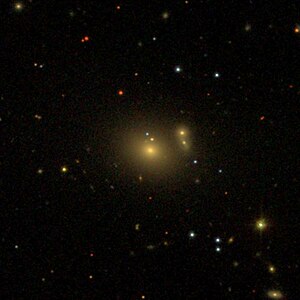NGC 2656
| Galaxy NGC 2656 |
|
|---|---|

|
|
| SDSS recording | |
| AladinLite | |
| Constellation | Big Bear |
|
Position equinox : J2000.0 , epoch : J2000.0 |
|
| Right ascension | 08 h 47 m 53.1 s |
| declination | + 53 ° 52 ′ 34 ″ |
| Appearance | |
| Morphological type | BrClG |
| Brightness (visual) | 13.9 likes |
| Brightness (B-band) | 14.9 mag |
| Angular expansion | 1 ′ × 1 ′ |
| Surface brightness | 14.0 mag / arcmin² |
| Physical data | |
| Redshift | 0.045491 ± 0.000153 |
| Radial velocity | (13638 ± 46) km / s |
|
Stroke distance v rad / H 0 |
(612 ± 43) · 10 6 ly (187.5 ± 13.1) Mpc |
| history | |
| discovery | John Herschel |
| Discovery date | February 10, 1831 |
| Catalog names | |
| NGC 2656 • PGC 24707 • CGCG 264-015 NED03 • MCG + 09-15-025 • 2MASX J08475313 + 5352344 • VV 703 NED03 • | |
NGC 2656 is a Hubble-type E-S0 elliptical galaxy in the constellation Great Bear . It is estimated to be 612 million light years from the Milky Way .
The object was discovered by John Herschel on February 10, 1831 .
